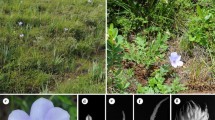Abstract
Sequences ofrbcL andndhF were analysed independently and in combination to resolve phylogenetic relationships inLabiatae s. l. Monophyly ofLabiatae s. l was supported by all three analyses.Congea tomentosa (Symphoremataceae) is nested withinLabiatae s. l. in therbcL analysis, but emerges as the sister group ofLabiatae s. l. in thendhF and combined analyses. Four noteworthy clades ofLabiate s. l. also are supported by all analyses corresponding to subfamiliesNepetoideae, Lamioideae, Pogostemonoideae andScutellarioideae. Monophyly of subfamiliesChloanthoideae andViticoideae is not supported. A clade comprisingTeucrioideae plusAjuga is supported byndhF and the combined analysis.
Similar content being viewed by others
References
Bentham, G., 1876:Verbenaceae andLabiatae. — InBentham, G., Hooker, J. D., (Eds): Genera plantarum,2, pp. 1131–1223. — London: Reeve.
Briquet, J., 1895:Verbenaceae. — InEngler, A., Prantl, K., (Eds): Die natürlichen Pflanzenfamilien,4/3a, pp. 132–182. — Leipzig: Engelmann.
—, 1895–1897:Labiatae. — InEngler, A., Prantl, K., (Eds): Die natürlichen Pflanzenfamilien,4/3a, pp. 183–375. — Leipzig: Engelmann.
Cantino, P. D., Sanders, R. W., 1986: Subfamilial classification ofLabiatae. — Syst. Bot.11: 163–185.
—, 1992a: Evidence for a polyphyletic origin of theLabiatae. — Ann. Missouri Bot. Gard.79: 361–379.
—, 1992b: Toward a phylogenetic classification of theLabiatae. — InHarley, R. M., Reynolds, T., (Eds): Advances in Labiate science, pp. 27–37. — Richmond: Royal Botanic Gardens, Kew.
—, 1992: Genera ofLabiatae: status and classification. — InHarley, R. M., Reynolds, T., (Eds): Advances in Labiate science, pp. 511–522. — Richmond: Royal Botanic Gardens Kew.
-Olmstead, R. G., Wagstaff, S. J., 1997: A comparison of phylogenetic nomenclature with the current system: a botanical case study. — Syst. Biol. (in press).
Cronquist, A., 1981: An integrated system of classification of flowering plants. — New York: Columbia University Press.
De Queiroz, A., Donoghue, M. J., Junhyong, K., 1995: Separate versus combined analysis of phylogenetic evidence. — Annual Rev. Ecol. Syst.26: 657–681.
Felsenstein, J., 1985: Confidence limits on phylogenies: an approach using the bootstrap. — Evolution39: 783–791.
Junell, S., 1934: Zur Gynäceummorphologie und Systematik der Verbenaceen und Labiaten. — Symb. Bot. Upsal.4: 1–219.
Huelsenbeck, J. P., Bull, J. J., Cunningham, C. W., 1996: Combining data in phylogenetic analysis. — Trends Ecol. Evol.11: 152–157.
Kaufman, M., Wink, M., 1995: Molecular systematics of theNepetoideae (familyLabiatae): phylogenetic implications fromrbcL gene sequences. — Z. Naturf., C49: 635–645.
Maddison, D. R., 1991: The discovery and importance of multiple islands of most-parsimonious trees. — Syst. Zool.40: 315–328.
Maddison, W. P., Maddison, D. R., 1992: MacClade vers. 3.1: analysis of phylogeny and character evolution. — Sunderland, Massachussetts: Sinauer.
Miyamoto, M. M., Fitch, W. M., 1995: Testing species phylogenies and phylogenetic methods with congruence. — Syst. Biol.44: 64–76.
Olmstead, R. G., Michaels, H. S., Scott, K. M., Palmer, J. D., 1992: Monophyly of theAsteridae and identification of their major lineages inferred from DNA sequences ofrbcL. — Ann. Missouri Bot. Grad.79: 249–265.
—, 1993: A parsimony analysis of theAsteridae sensu lato based onrbcL sequences. — Ann. Missouri Bot. Gard.80: 700–722.
—, 1994: Chloroplast DNA systematics: a review of methods and data analysis. — Amer. J. Bot.81: 1205–1224.
—, 1995: Polyphyletic origin of theScrophulariaceae: evidence fromrbcL andndhF sequences. — Ann. Missouri Bot. Gard.82: 176–193.
Ryding, O., 1995: Pericarp structure and phylogeny of theLamiaceae-Verbenaceae complex. — Pl. Syst. Evol.198: 101–141.
Steane, D. A., Scotland, R. W., Mabberley, D. J., Wagstaff, S. J., Reeves, P. A., Olmstead, R. G., 1997: Phylogenetic relationships ofClerodendrum s. l. (Lamiaceae) inferred from chloroplast DNA. — Syst. Bot. (in press).
Swofford, D. L., 1993: Phylogenetic analysis using parsimony (PAUP vers. 3.1.1). — Champaign: Illinois Natural History Survey.
Thorne, R. F., 1992: Classification and geography of the flowering plants. — Bot. Rev.58: 225–348.
Valdés III, L. J., Hatfield, G. M., Koreeda, M., Paul, A. G., 1987a: Studies ofSalvia divinorum (Lamiaceae), an hallucinogenic mint from the Sierra Mazateca in Oaxaca, Central Mexico. — Econ. Bot.41: 283–291.
—, 1987b:Coleus barbatus (C. forskohlii) (Lamiaceae) and the potential new drug forskolin (coleonol). — Econ. Bot.41: 474–483.
Wagstaff, S. J., Olmstead, R. G., 1997: Phylogeny ofLabiatae andVerbenaceae inferred fromrbcL sequences. — Syst. Bot. (in press).
—, 1995: A phylogenetic analysis of restriction site variation in subfamilyNepetoideae (Labiatae). — Amer. J. Bot.82: 886–892.
Author information
Authors and Affiliations
Rights and permissions
About this article
Cite this article
Wagstaff, S.J., Hickerson, L., Spangler, R. et al. Phylogeny inLabiatae s. l., inferred from cpDNA sequences. Pl Syst Evol 209, 265–274 (1998). https://doi.org/10.1007/BF00985232
Received:
Revised:
Accepted:
Issue Date:
DOI: https://doi.org/10.1007/BF00985232




